
(a)
Interpretation:
Determine the structural formula from the given molecular formula:
20 aromatic
Concept Introduction:
The spatial arrangement of atom within a compound that are joined together is identified with the help of structural formula.
Explanation of Solution
The molecular formula C7 H9 N is 20 on the
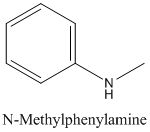
(b)
Interpretation:
Determine the structural formula from the given molecular formula:
30 aromatic amines, C8 H11 N.
Concept Introduction:
The spatial arrangement of atom within a compound that are joined together is identified with the help of structural formula.
Explanation of Solution
Tertiary amines are those compounds in which three hydrogen atoms of ammonia are replaced by alkyl or aryl groups. They are represented as R3 -N or 
The molecular formula, C8 H11 N is 30 on the aromatic amine. Hence, it has six-membered ring. The nitrogen atom is attached to three groups in which one is an aryl group and the other two are methyl groups.
Thus, the structural formula for the molecular formula C8 H11 N is as below:
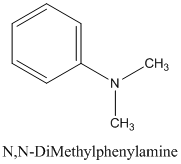
(c)
Interpretation:
Determine the structural formula from the given molecular formula:
10 aliphatic amines, C7 H9 N.
Concept Introduction:
The spatial arrangement of atom within a compound that are joined together is identified with the help of structural formula.
Explanation of Solution
Primary amines are those compounds in which one of the hydrogen atoms of ammonia is replaced by an alkyl or an aryl group. They are represented as 
The molecular formula C7 H9 N is 10 on the aliphatic amine. Hence it has
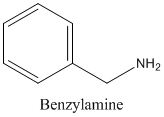
(d)
Interpretation:
Determine the structural formula from the given molecular formula:
A chiral 10 amine, C4 H11 N.
Concept Introduction:
The spatial arrangement of atom within a compound that are joined together is identified with the help of structural formula.
Explanation of Solution
Primary amines are those compounds in which one of the hydrogen atoms of ammonia is replaced by an alkyl or aryl group. They are represented as
The carbon atom attach to four different group is called a chiral atom. When a molecule possesses such atom, then they are not superimposable on their mirror image.
The molecular formula C4 H11 N is 10 on the aliphatic amine, and it is a chiral molecule. Hence, the chiral carbon atom is attached to four different groups, which include -NH2 group, the -CH3 group, the -CH2 group and the -H group. The structural formula of C4 H11 N is as below:
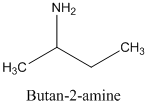
(e)
Interpretation:
Determine the structural formula from the given molecular formula:
A 30 heterocyclic amine, C5 H11 N.
Concept Introduction:
The spatial arrangement of atom within a compound that are joined together is identified with the help of structural formula.
Explanation of Solution
Tertiary amines are those compounds in which three hydrogen atoms of ammonia are replaced by alkyl or aryl groups. They are represented as R3 -N or 
The carbon atom attach to four different group is called a chiral atom. When a molecule possesses such atom, then they are not superimposable on their mirror image.
The molecular formula C5 H11 N is 30 on the heterocyclic amine. This structure has a five membered heterocyclic ring. This ring contains four carbons and one nitrogen atom. The nitrogen atom in the ring is bonded to the methyl group. The structural formula of C4 H11 N is as below:

(f)
Interpretation:
Determine the structural formula from the given molecular formula:
A trisubstituted 10 aromatic amine, C9 H13 N.
Concept Introduction:
The spatial arrangement of atom within a compound that are joined together is identified with the help of structural formula.
Explanation of Solution
Primary amines are those compounds in which one of the hydrogen atoms of ammonia is replaced by an alkyl or aryl group. They are represented as
The molecular formula C9 H13 N is tri substituted 10 on the aromatic amine. Hence, it has six membered rings with three methyl groups. The structural formula of C5 H13 N is as below:
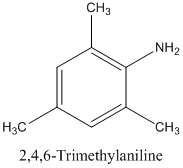
(g)
Interpretation:
Determine the structural formula from the given molecular formula:
A chiral quaternary ammonium salt, C9 H22 NCl.
Concept Introduction:
The spatial arrangement of atom within a compound that are joined together is identified with the help of structural formula.
Explanation of Solution
Quaternary amines are those compounds in which all four of the hydrogen atoms of the ammonium ion are replaced by an alkyl or aryl group. It is an ionic quaternary salt.
When the carbon atom is attached to four different groups, it is called a chiral atom. When a molecule possesses such an atom, then it is not super imposable on its mirror image.
The molecular formula C9 H22 NCl is a quaternary amine and it is a chiral molecule. Hence, the chiral nitrogen atom is attached to four different groups, which include -CH2 CH3 group, the -CH2 CH2 CH3 group, the -CH3 CHCH3 group, and the -CH3 group. Therefore, the quaternary ammonium salt of C9 H22 NCl is as below:
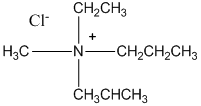
Want to see more full solutions like this?
Chapter 15 Solutions
INTRO.TO GENERAL,ORGAN...-OWLV2 ACCESS
- What is the missing reactant in this organic reaction? R+ HO-C-CH2-CH3 0= CH3 CH3 —CH, C−NH—CH CH3 + H₂O Specifically, in the drawing area below draw the condensed structure of R. If there is more than one reasonable answer, you can draw any one of them. If there is no reasonable answer, check the No answer box under the drawing area. Note for advanced students: you may assume no products other than those shown above are formed. No Answer Click anywhere to draw the first atom of your structure. €arrow_forward个 CHEM&131 9267 - $25 - Intro to Mail - Hutchison, Allison (Student x Aktiv Learnin https://app.aktiv.com Draw the product of the reaction shown below. Ignore inorganic byproducts. + Na2Cr2O7 Acetone, H2SO4 Type here to search Dryng OH W Prarrow_forwardPredict the products of this organic reaction: OH + NaOH A? Specifically, in the drawing area below draw the skeletal ("line") structure of the product, or products, of this reaction. (If there's more than one product, draw them in any arrangement you like, so long as they aren't touching.) If there aren't any products because this reaction won't happen, check the No reaction box under the drawing area. No reaction Click and drag to start drawing a structure. ✓ Sarrow_forward
- Predict the products of this organic reaction: CH3-C-O-CH2-CH2-C-CH3 + H₂O ? A Specifically, in the drawing area below draw the condensed structure of the product, or products, of this reaction. (If there's more than one product, draw them in any arrangement you like, so long as they aren't touching.) If there aren't any products because this reaction won't happen, check the No reaction box under the drawing area. No reaction Click anywhere to draw the first atom of your structure. :☐ darrow_forwardDE d. Draw an arrow pushing mechanism for the following IN O CI N fo 人 P Polle DELL prt sc home end ins F5 F6 F7 F8 F9 F10 F11 F12arrow_forwardPredict the products of this organic reaction: + H₂O H* ? A Specifically, in the drawing area below draw the skeletal ("line") structure of the product, or products, of this reaction. (If there's more than one product, draw them in any arrangement you like, so long as they aren't touching.) If there aren't any products because this reaction won't happen, check the No reaction box under the drawing area. No Reaction Click and drag to start drawing a structure.arrow_forward
- Predict the major organic products of the reaction below and draw them on right side of the arrow. If there will be no significant reaction, check the box below the drawing area instead. C Cl CH, OH There will be no significant reaction. + pyridine G Click and drag to start drawing a structure.arrow_forwardWhat is the missing reactant in this organic reaction? H R+ H2O Δ OH 0= CH3-CH-O-CH3 + CH3-C-OH Specifically, in the drawing area below draw the condensed structure of R. If there is more than one reasonable answer, you can draw any one of them. If there is no reasonable answer, check the No answer box under the drawing area. No Answer Click anywhere to draw the first atom of your structure. dyarrow_forwardYou are trying to determine whether the following organic reaction can be done in a single synthesis step. If so, add any missing reagents or conditions in the drawing area below. If it isn't possible to do this reaction in a single synthesis step, check the box below the drawing area instead. Note for advanced students: if you have a choice of reagents to add, you should choose the least reactive and most economical reagents possible. Cl It isn't possible to do this reaction in a single synthesis step. + T OHarrow_forward
- Predict the products of this organic reaction: CH3 O CH3-CH-C-O-CH2-CH2-CH3 + H₂OH+ Η ? A Specifically, in the drawing area below draw the condensed structure of the product, or products, of this reaction. (If there's more than one product, draw them in any arrangement you like, so long as they aren't touching.) If there aren't any products because this reaction won't happen, check the No reaction box under the drawing area. No Reaction Click anywhere to draw the first atom of your structure.arrow_forward€ CH3-CH-C-O-CH2-CH2-CH3 + NaOH A? Specifically, in the drawing area below draw the condensed structure of the product, or products, of this reaction. (If there's more than one product, draw them in any arrangement you like, so long as they aren't touching.) If there aren't any products because this reaction won't happen, check the No reaction box under the drawing area. Predict the products of this organic reaction: CH3 O Click anywhere to draw the first atom of your structure. No reaction ✓ Garrow_forwardA molecule can have a temporary or permanent depending on the structure and the way the electrons can move. True Falsearrow_forward
 Introduction to General, Organic and BiochemistryChemistryISBN:9781285869759Author:Frederick A. Bettelheim, William H. Brown, Mary K. Campbell, Shawn O. Farrell, Omar TorresPublisher:Cengage Learning
Introduction to General, Organic and BiochemistryChemistryISBN:9781285869759Author:Frederick A. Bettelheim, William H. Brown, Mary K. Campbell, Shawn O. Farrell, Omar TorresPublisher:Cengage Learning Organic ChemistryChemistryISBN:9781305580350Author:William H. Brown, Brent L. Iverson, Eric Anslyn, Christopher S. FootePublisher:Cengage Learning
Organic ChemistryChemistryISBN:9781305580350Author:William H. Brown, Brent L. Iverson, Eric Anslyn, Christopher S. FootePublisher:Cengage Learning Chemistry: The Molecular ScienceChemistryISBN:9781285199047Author:John W. Moore, Conrad L. StanitskiPublisher:Cengage Learning
Chemistry: The Molecular ScienceChemistryISBN:9781285199047Author:John W. Moore, Conrad L. StanitskiPublisher:Cengage Learning General, Organic, and Biological ChemistryChemistryISBN:9781285853918Author:H. Stephen StokerPublisher:Cengage Learning
General, Organic, and Biological ChemistryChemistryISBN:9781285853918Author:H. Stephen StokerPublisher:Cengage Learning Organic And Biological ChemistryChemistryISBN:9781305081079Author:STOKER, H. Stephen (howard Stephen)Publisher:Cengage Learning,
Organic And Biological ChemistryChemistryISBN:9781305081079Author:STOKER, H. Stephen (howard Stephen)Publisher:Cengage Learning, ChemistryChemistryISBN:9781305957404Author:Steven S. Zumdahl, Susan A. Zumdahl, Donald J. DeCostePublisher:Cengage Learning
ChemistryChemistryISBN:9781305957404Author:Steven S. Zumdahl, Susan A. Zumdahl, Donald J. DeCostePublisher:Cengage Learning





